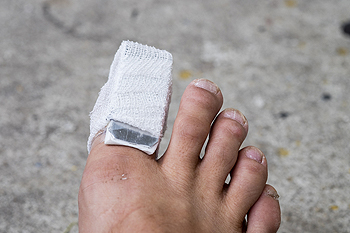Blog
Items filtered by date: June 2024
Benefits of Limb Salvage Surgery
 Limb salvage surgery is a critical procedure used to avoid foot or toe amputation due to severe injuries, infections, or cancers. During the surgery, doctors remove the damaged or diseased parts of the foot while preserving as much healthy tissue as possible. This requires advanced reconstruction techniques to keep the foot functional. Limb salvage surgery helps patients maintain physical abilities and provides significant emotional benefits to enhance the overall quality of their lives. Complex Infections, such as osteomyelitis, can destroy bone and surrounding tissue, requiring careful surgical intervention. Additionally, conditions like bone cancers, severe diabetic ulcers, and peripheral artery disease can severely impair blood flow and tissue health, making limb salvage surgery necessary to prevent amputation. If you or someone you know struggles with severe trauma, infections, bone cancers, diabetic ulcers, or poor circulation affecting your feet, it is suggested you make an appointment with a podiatrist for evaluation and treatment options.
Limb salvage surgery is a critical procedure used to avoid foot or toe amputation due to severe injuries, infections, or cancers. During the surgery, doctors remove the damaged or diseased parts of the foot while preserving as much healthy tissue as possible. This requires advanced reconstruction techniques to keep the foot functional. Limb salvage surgery helps patients maintain physical abilities and provides significant emotional benefits to enhance the overall quality of their lives. Complex Infections, such as osteomyelitis, can destroy bone and surrounding tissue, requiring careful surgical intervention. Additionally, conditions like bone cancers, severe diabetic ulcers, and peripheral artery disease can severely impair blood flow and tissue health, making limb salvage surgery necessary to prevent amputation. If you or someone you know struggles with severe trauma, infections, bone cancers, diabetic ulcers, or poor circulation affecting your feet, it is suggested you make an appointment with a podiatrist for evaluation and treatment options.
Limb salvage can be an effective way in preventing the need for limb amputation. If you have diabetes, cancer, or any other condition that could lead to foot amputation if left unchecked, consult with one of our doctors from Favor Foot Ankle Leg & Wound Center. Our doctors will assess your condition and provide you with quality foot and ankle treatment.
What Is Limb Salvage?
Limb salvage is the attempt of saving a limb, such as the foot from amputation. Podiatrists also try to make sure that there is enough function in the foot after the salvage that it is still usable. Diabetes is the number one cause of non-traumatic amputations in the United States. Those with diabetes experience poor blood circulation, which prevents proper healing of an ulcer. If the ulcer is left uncheck, it could become infected, which could result in the need for amputation.
However, there are other causes as well, such as cancer and traumatic injury. Links between higher mortality rates and amputation have been found. This translates into higher healthcare costs, and a reduced quality of life and mobility for amputees. Podiatrists have attempted to increase the prevalence of limb salvage in an attempt to solve these issues.
Diagnosis and Treatment
Limb salvage teams have grown in recent years that utilize a number of different treatments to save the infected limb. This includes podiatrists that specialize in wound care, rehabilitation, orthotics, and surgery. Through a combination of these methods, limb salvage has been found to be an effective treatment for infected limbs, and as an alternative to amputation. Podiatrists will first evaluate the potential for limb salvage and determine if the limb can be saved or must be amputated.
If you have any questions, please feel free to contact our office located in South Amboy, NJ . We offer the newest diagnostic and treatment technologies for all your foot care needs.
Causes and Diagnosis of Peripheral Artery Disease

Peripheral artery disease, or PAD, poses significant challenges for foot health, stemming from restricted blood flow to the lower extremities. This condition, often caused by atherosclerosis, involves the buildup of fatty deposits in the arteries, leading to narrowed or blocked blood vessels. The diminished blood supply to the feet can result in various symptoms, including pain, cramping, numbness, and weakness, particularly during physical activity. Left untreated, PAD can contribute to serious complications such as foot ulcers, infections, and delayed wound healing. Diagnosing PAD typically involves a comprehensive evaluation by a podiatrist. This process includes a thorough medical history review, assessment of risk factors such as smoking and diabetes, and a physical examination focused on evaluating circulation in the legs and feet. Specialized diagnostic tests, such as ankle-brachial index, or ABI measurement, Doppler ultrasound, and angiography, may also be employed to confirm the diagnosis and determine the extent of arterial blockages. If you are experiencing any of the foot symptoms mentioned above, it is suggested that you consult a podiatrist who can accurately diagnose and offer relief solutions for PAD.
Peripheral artery disease can pose a serious risk to your health. It can increase the risk of stroke and heart attack. If you have symptoms of peripheral artery disease, consult with one of our doctors from Favor Foot Ankle Leg & Wound Center. Our doctors will assess your condition and provide you with quality foot and ankle treatment.
Peripheral artery disease (PAD) is when arteries are constricted due to plaque (fatty deposits) build-up. This results in less blood flow to the legs and other extremities. The main cause of PAD is atherosclerosis, in which plaque builds up in the arteries.
Symptoms
Symptoms of PAD include:
- Claudication (leg pain from walking)
- Numbness in legs
- Decrease in growth of leg hair and toenails
- Paleness of the skin
- Erectile dysfunction
- Sores and wounds on legs and feet that won’t heal
- Coldness in one leg
It is important to note that a majority of individuals never show any symptoms of PAD.
Diagnosis
While PAD occurs in the legs and arteries, Podiatrists can diagnose PAD. Podiatrists utilize a test called an ankle-brachial index (ABI). An ABI test compares blood pressure in your arm to you ankle to see if any abnormality occurs. Ultrasound and imaging devices may also be used.
Treatment
Fortunately, lifestyle changes such as maintaining a healthy diet, exercising, managing cholesterol and blood sugar levels, and quitting smoking, can all treat PAD. Medications that prevent clots from occurring can be prescribed. Finally, in some cases, surgery may be recommended.
If you have any questions, please feel free to contact our office located in South Amboy, NJ . We offer the newest diagnostic and treatment technologies for all your foot care needs.
What Can Be Done About Broken Toes
 Toe fractures can occur due to various reasons, such as stubbing, dropping heavy objects, or even sports injuries. The impact can cause the toe bone to break, leading to pain, swelling, and difficulty in walking. Individuals may experience tenderness, bruising, and sometimes even a visible deformity depending on the severity of the fracture. To evaluate toe fractures, podiatrists may perform physical examinations and order X-rays to determine the type and severity of the break. Treatment options range from simple rest and elevation to immobilization using splints, buddy taping, or wearing a special shoe. In severe cases or for fractures that involve displaced bones, surgery may be necessary to realign and stabilize the bones. If you have a broken toe, it is suggested that you schedule an appointment with a podiatrist for treatment to facilitate optimal healing and prevent complications.
Toe fractures can occur due to various reasons, such as stubbing, dropping heavy objects, or even sports injuries. The impact can cause the toe bone to break, leading to pain, swelling, and difficulty in walking. Individuals may experience tenderness, bruising, and sometimes even a visible deformity depending on the severity of the fracture. To evaluate toe fractures, podiatrists may perform physical examinations and order X-rays to determine the type and severity of the break. Treatment options range from simple rest and elevation to immobilization using splints, buddy taping, or wearing a special shoe. In severe cases or for fractures that involve displaced bones, surgery may be necessary to realign and stabilize the bones. If you have a broken toe, it is suggested that you schedule an appointment with a podiatrist for treatment to facilitate optimal healing and prevent complications.
A broken toe can be very painful and lead to complications if not properly fixed. If you have any concerns about your feet, contact one of our doctors from Favor Foot Ankle Leg & Wound Center. Our doctors will treat your foot and ankle needs.
What to Know About a Broken Toe
Although most people try to avoid foot trauma such as banging, stubbing, or dropping heavy objects on their feet, the unfortunate fact is that it is a common occurrence. Given the fact that toes are positioned in front of the feet, they typically sustain the brunt of such trauma. When trauma occurs to a toe, the result can be a painful break (fracture).
Symptoms of a Broken Toe
- Throbbing pain
- Swelling
- Bruising on the skin and toenail
- The inability to move the toe
- Toe appears crooked or disfigured
- Tingling or numbness in the toe
Generally, it is best to stay off of the injured toe with the affected foot elevated.
Severe toe fractures may be treated with a splint, cast, and in some cases, minor surgery. Due to its position and the pressure it endures with daily activity, future complications can occur if the big toe is not properly treated.
If you have any questions please feel free to contact our office located in South Amboy, NJ . We offer the newest diagnostic and treatment technologies for all your foot and ankle needs.
Wounds That Don't Heal Need to Be Checked
The Benefits of Ankle Stretches

Ankle stretches play a pivotal role in maintaining optimal foot and lower limb health, offering a multitude of benefits for individuals of all ages and activity levels. These stretches help improve ankle flexibility, range of motion, and proprioception, reducing the risk of injuries such as sprains and strains. Additionally, ankle stretches alleviate tightness in the calf muscles and Achilles tendon, promoting better posture and gait mechanics. Performing ankle stretches can also enhance balance and stability, vital for activities like walking, running, and sports participation. To perform a basic ankle stretch, sit on the floor with your legs extended, then loop a resistance band or towel around the ball of one foot and gently pull it toward you, feeling a stretch in the calf and ankle. Hold the stretch for 15 to 30 seconds, then switch sides. Another effective stretch involves standing with one foot behind the other, bending the back knee slightly to stretch the calf and ankle. By incorporating these stretches into a regular routine, individuals can reap the benefits of improved ankle flexibility and function. If you have foot pain that may be impacted from having stiff ankles, it is suggested that you visit a podiatrist.
Stretching the feet is a great way to prevent injuries. If you have any concerns with your feet consult with one of our doctors from Favor Foot Ankle Leg & Wound Center. Our doctors will assess your condition and provide you with quality foot and ankle treatment.
Stretching the Feet
Being the backbone of the body, the feet carry your entire weight and can easily become overexerted, causing cramps and pain. As with any body part, stretching your feet can serve many benefits. From increasing flexibility to even providing some pain relief, be sure to give your feet a stretch from time to time. This is especially important for athletes or anyone performing aerobic exercises, but anyone experiencing foot pain or is on their feet constantly should also engage in this practice.
Great ways to stretch your feet:
- Crossing one leg over the others and carefully pull your toes back. Do 10-20 repetitions and repeat the process for each foot
- Face a wall with your arms out and hands flat against the wall. Step back with one foot and keep it flat on the floor while moving the other leg forward. Lean towards the wall until you feel a stretch. Hold for 30 seconds and perform 10 repetitions for each foot
- Be sure not to overextend or push your limbs too hard or you could risk pulling or straining your muscle
Individuals who tend to their feet by regular stretching every day should be able to minimize foot pain and prevent new problems from arising.
If you have any questions, please feel free to contact our office located in South Amboy, NJ . We offer the newest diagnostic and treatment technologies for all your foot care needs.

